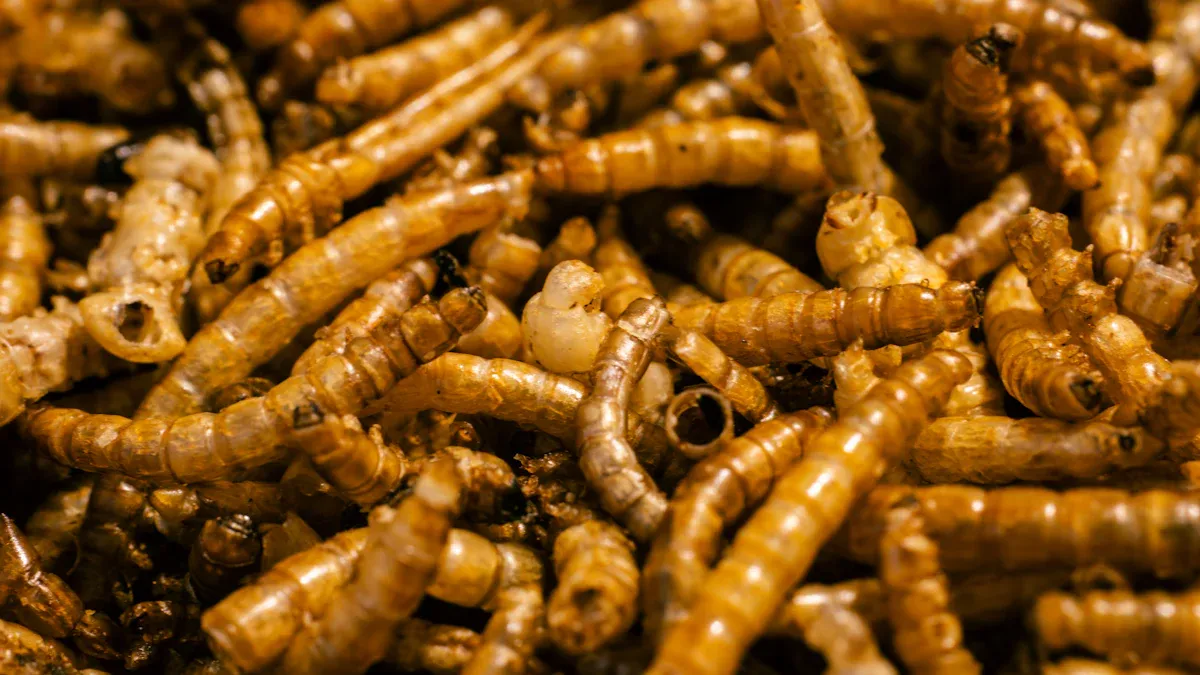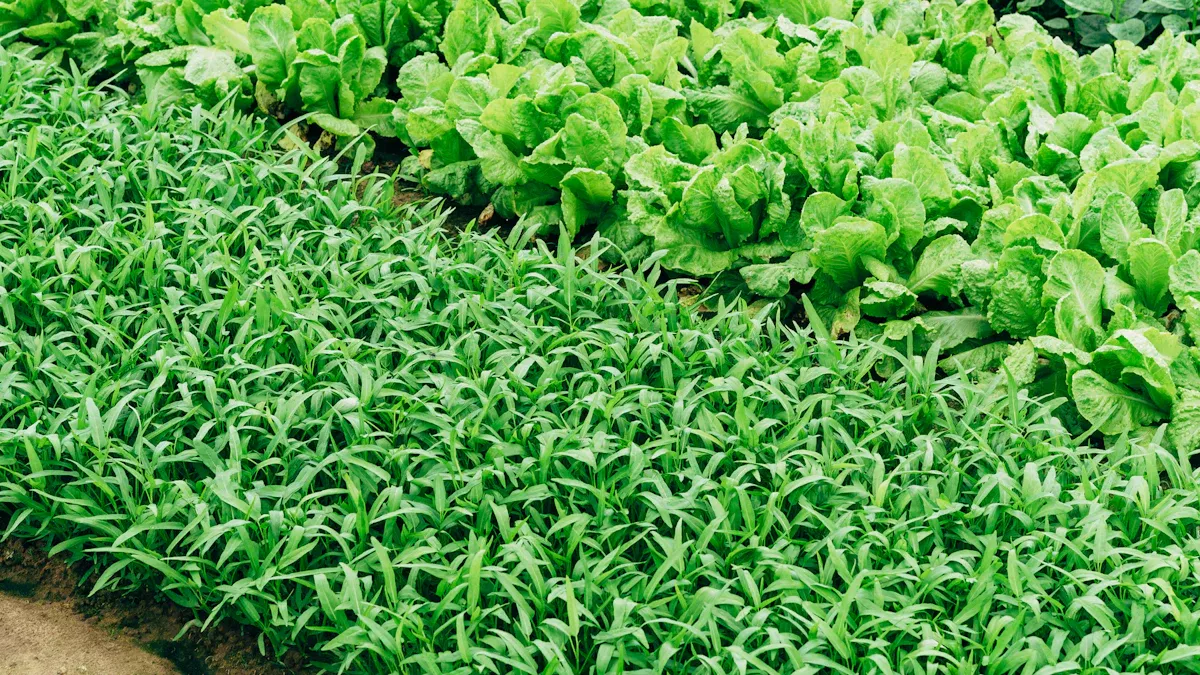
Have you noticed how Australian organic farms are embracing innovative solutions? One standout is the use of dried mealworm for farms. These nutrient-packed insects are rich in protein, vitamins, and minerals, making them a game-changer for sustainable agriculture. With mealworm manufacturers advancing production technologies, farmers now have access to eco-friendly, high-quality supplies that align with organic farming standards.
Key Takeaways
- Dried mealworms are a healthy option for organic farms. They have lots of protein and nutrients that help soil and crops grow better.
- Mealworm frass, used as fertilizer, makes soil stronger and helps good microbes grow. This means farmers need fewer chemical fertilizers.
- Using dried mealworms is better for the planet. They use less water and land than regular farm animals, making them a greener choice.
Why Organic Farms Are Turning to Dried Mealworm for Farms
Nutritional Benefits of Dried Mealworms
You might be surprised to learn how nutrient-packed dried mealworms are. They’re loaded with protein, essential amino acids, and healthy fats, making them a powerhouse for organic farming. Studies show that mealworms contain about 25% protein and 12% fat, which is comparable to traditional livestock like beef and chicken. Plus, they’re versatile! Farmers can use them in various ways, from enriching soil to feeding livestock. Cooking methods like boiling or vacuum cooking even enhance their nutritional quality while keeping them safe to use. With such benefits, it’s no wonder dried mealworm for farms is gaining popularity.
Compatibility with Organic Farming Standards
You may wonder if dried mealworms fit into organic farming. While some regions, like Europe, haven’t fully approved them for organic certification yet, there’s growing potential. Experts believe that mealworms could soon meet organic standards due to their ecological benefits and consumer acceptance. Their ability to reduce environmental impact while boosting productivity makes them a strong candidate for future regulations. For now, many Australian organic farms are already reaping the rewards of this sustainable solution.
Addressing Common Challenges in Organic Farming
Organic farming isn’t without its challenges, right? That’s where dried mealworms shine. Research shows that mealworm frass (a byproduct) improves soil health, boosts plant growth, and even helps crops resist stress. For example, studies found that mealworm frass enhanced nutrient uptake in barley and improved flower quality in marigolds. By using dried mealworm for farms, you can tackle common issues like soil fertility and crop resilience naturally.
Benefits of Dried Mealworm for Farms

Improving Soil Health and Fertility
Healthy soil is the foundation of any successful farm, and dried mealworms can help you achieve just that. When you use mealworm frass (the nutrient-rich byproduct of mealworms), it acts as a natural fertilizer. It’s packed with nitrogen, phosphorus, and potassium—key nutrients that plants need to thrive. Unlike synthetic fertilizers, mealworm frass improves soil structure and promotes beneficial microbial activity. This means your soil stays fertile for longer, reducing the need for chemical inputs.
Here’s a quick comparison of mealworms versus traditional livestock in terms of environmental impact:
| Aspect | Mealworms | Traditional Livestock |
|---|---|---|
| Water Footprint (m3/t) | 4341 | 15000 (Beef) |
| Land Use | Low | High |
| GHG Emissions | Low | High |
By choosing dried mealworm for farms, you’re not just improving soil health—you’re also making an eco-friendly choice.
Enhancing Crop Yields Naturally
Wouldn’t it be great if your crops grew stronger and healthier without relying on synthetic chemicals? Dried mealworms can make that happen. Their frass enhances nutrient uptake in plants, leading to better growth and higher yields. For instance, studies have shown that barley and marigolds treated with mealworm frass grew more robustly and produced better-quality flowers. This natural boost can help you meet production goals while keeping your farm organic.
Promoting Sustainable Agricultural Practices
Sustainability is more than a buzzword—it’s the future of farming. Dried mealworms are a game-changer in this regard. They require significantly less water and land compared to traditional livestock. For example, producing one ton of edible protein from mealworms uses only 4341 m3 of water, compared to 15,000 m3 for beef. Plus, mealworms emit far fewer greenhouse gases like CO2 and methane.
| Emission Type | Mealworms | Beef | Chicken |
|---|---|---|---|
| Ammonia | Low | High | Medium |
| CO2 | Low | High | Medium |
| N2O | Low | High | Medium |
| CH4 | Low | High | Medium |
By incorporating dried mealworm for farms, you’re not only reducing your carbon footprint but also supporting a circular economy. Mealworms can even replace imported feed like fishmeal, helping local agriculture thrive.
Environmental and Economic Impact
Reducing Agricultural Waste
Have you ever wondered how much waste farming generates? Organic farms often struggle with leftover plant material, manure, and other byproducts. That’s where dried mealworms come in. These tiny insects are nature’s recyclers. They can consume organic waste, like crop residues and food scraps, and turn it into high-quality protein and fertilizer. By using dried mealworm for farms, you’re not just reducing waste—you’re giving it a second life. This approach helps farms cut down on landfill contributions and promotes a circular economy. It’s a win-win for you and the environment.
Cost-Effective Solutions for Farmers
Farming can be expensive, especially when it comes to feed and fertilizers. But dried mealworms offer a cost-effective alternative. They’re packed with nutrients, making them a great replacement for traditional livestock feed like soybeans. Plus, mealworm frass works as a natural fertilizer, reducing your reliance on costly synthetic options. Studies show that mealworms are more efficient to produce than cattle or pigs, thanks to their lower land and water requirements. Here’s a quick comparison to show how they stack up:
| Aspect | Mealworms | Soybeans |
|---|---|---|
| Environmental Impact | Greater energy usage | Lower energy usage |
| Nutritional Quality | Comparable to soy | Standard for livestock feed |
| Cost-Effectiveness | Potentially more cost-effective | Established market price |
Switching to mealworms can help you save money while staying eco-friendly.
Lowering Farming’s Carbon Footprint
Did you know that traditional livestock farming is one of the biggest contributors to greenhouse gas emissions? Dried mealworms offer a greener alternative. Life cycle assessments show that mealworms have a much lower global warming potential compared to beef, pork, and chicken. They also use less land and fossil energy. For example, producing one kilogram of edible protein from mealworms requires far less land than raising cattle. By adopting dried mealworm for farms, you’re taking a big step toward reducing your carbon footprint and supporting sustainable agriculture.
Success Stories from Australian Organic Farms
Case Studies of Effective Implementation
Australian organic farms are leading the way in adopting dried mealworm for farms. These farms have seen remarkable results by integrating mealworms into their practices. Let’s take a closer look at some key insights:
| Aspect | Details |
|---|---|
| Environmental Benefits | Mealworms are a cost-effective and environmentally friendly alternative to traditional livestock feed, with lower ammonia and greenhouse gas emissions. |
| Practical Applications | Farmers use mealworms as a sustainable protein source, meeting both livestock and soil nutritional needs. |
| Recommendations for Future Research | Pilot projects are encouraged to assess the practicality of mealworm-based feed and explore its environmental benefits further. |
These case studies highlight how mealworms can transform farming. By replacing traditional feed with mealworms, farmers reduce emissions and improve sustainability. The versatility of mealworms also allows them to be used in multiple ways, from enriching soil to feeding livestock. This adaptability makes them a valuable addition to organic farming.
Farmer Testimonials on Using Dried Mealworms
Farmers across Australia are sharing their success stories. Here’s what they’re saying:
“Switching to dried mealworms has been a game-changer for my farm. My soil is healthier, and my crops are thriving like never before!” – Sarah, an organic farmer in Victoria.
“I was skeptical at first, but mealworms have exceeded my expectations. They’re easy to use and have reduced my reliance on synthetic fertilizers.” – Tom, a livestock farmer in Queensland.
These testimonials show how dried mealworms are making a real difference. Farmers are seeing healthier crops, better soil, and reduced costs. If you’re looking for a sustainable solution, mealworms might be the answer you’ve been searching for.
Dried mealworms are revolutionizing organic farming by offering a sustainable, nutrient-packed solution. Their benefits go beyond productivity.
- Mealworms convert feed as efficiently as chickens and use nitrogen better than cattle.
- Producing 1 kg of mealworm protein emits just 20.4 kg CO2-eq and uses only 22.38 m² of land.
Switching to mealworms means healthier farms and a greener planet. 🌱
FAQ
What makes dried mealworm for farms eco-friendly?
Mealworms use less water and land than livestock. They emit fewer greenhouse gases, making them a sustainable choice for organic farming.
Can dried mealworms replace synthetic fertilizers?
Yes! Mealworm frass acts as a natural fertilizer. It enriches soil with essential nutrients like nitrogen, phosphorus, and potassium.
Are dried mealworms safe for livestock feed?
Absolutely. Mealworms are rich in protein and amino acids. They’re a nutritious and safe option for feeding livestock.


